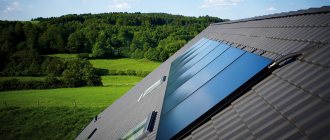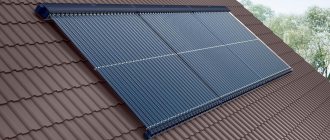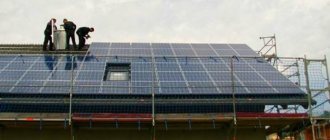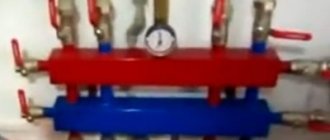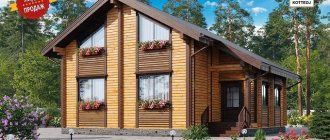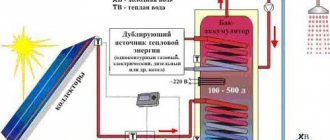Heating systems in private country houses can be built on completely different energy sources. These can be systems based on boilers, the heating of the coolant in which is based on the combustion of various types of fuel, such as gas or liquid diesel fuel. Boilers can be heated with coal or wood pellets. In any case, in order to put such a heating system into operation, in addition to the actual installation of heating boilers, you will also have to purchase the fuel itself. But this expense item can, in a certain situation, even exceed the cost of installing a heating system. And this is where solar collectors for heating a home can come to the rescue.
Solar heating collectors on the roof of a private house
Pros and cons of solar collectors for home heating
The use of renewable energy sources in autonomous heating systems involves monetary costs solely for the purchase and installation of such a system, as well as for its maintenance and necessary maintenance repairs. But after installation, such systems begin to work completely autonomously and absolutely free for their owners. In fact, you don’t need to pay anything for the sun’s rays.
Some consumers express doubts about the effectiveness of the installation and use of solar collectors in central Russia, where there are not as many sunny days as, for example, in Kuban. However, solar collectors for heating water can be used not only as the main source of heating the coolant, but also as an additional source. In this case, the solar water heating device will work only when there are no clouds in the sky, and at other times, classic heating devices, such as gas boilers, can be used.
heating circuit
As for the efficiency of using solar collectors in terms of price-return ratio, we recommend that you pay attention to the northern provinces of China. A significant number of houses in these Chinese cities and villages are equipped with solar collectors for heating. The climate and solar activity in these areas are not too different from the neighboring Russian regions: for example, the Khabarovsk and Trans-Baikal territories. You yourself understand that the climate in Transbaikalia, the place where convicts were exiled in tsarist times, is not at all sweet. This means that the use of solar collectors for heating houses even in Russian regions with the harshest climate is not only possible, but also quite popular and economical.
Real heating methods
As you understand from the above, it is quite difficult (and expensive) to implement full-fledged electric heating of a house with solar panels. Not every owner will decide to buy and install panels on an area of 100–150 m² in order to warm up a small house or cottage. This means that the circuit of electric boiler + water system + heating radiators is eliminated.
But the idea of heating with solar modules still cannot be called a utopia. We list the options implemented by homeowners in practice:
- panels plus inverter air conditioners with a COP efficiency of 3.5–4;
- connecting batteries directly to electric heaters without an inverter;
- construction of a full-fledged solar power plant, sale of electricity to the state, the proceeds go to pay for traditional heating.
Addition. There is no point in discussing the use of panels as additional energy sources for main heating - this is an obvious solution.
Let's start with the third option, which is of interest to entrepreneurs. In countries where the state has established a so-called feed-in tariff, the homeowner can receive electricity from renewable sources and feed it into the general energy grid, making a profit. That is, the homeowner purchases the same 200–300 solar panels, but sells the energy at a good price, rather than wasting it in vain.
Operating principles of heating manifolds
One of the main designs of solar heating collectors are vacuum-type devices. Based on the name, it is obvious that such devices will collect radiant solar energy and transfer it to heat water or other coolant. This is actually the case in reality.
Autonomous heating systems incorporating solar collectors consist of the following main components:
- The solar heating collector itself is a device that is placed in direct sunlight and serves to heat the coolant,
- Heat exchange circuit: a pipeline system through which hot coolant moves, gradually transferring its heat to heated rooms,
- Thermal accumulator: This is a water tank in which heated water is stored for future use.
So, the solar collector, consisting of pipes containing not yet heated coolant, is exposed to direct sunlight. The coolant fluid (usually water, but possibly special antifreeze) enters the collector, is heated there and transferred to the heat exchange circuit, which is mounted inside the heat accumulator. The heated coolant, moving inside the pipelines of the heat exchange circuit, heats the water in the heat accumulator. The heated water is stored in a tank with a heat accumulation function until it becomes necessary to use it, for example until it is supplied to the circuits of the home heating system and heating radiators or to the domestic hot water supply circuits, for example for washing.
Water supply circulation in the heating manifold
Since solar energy acts on the collector completely free of charge, the system at any time has heated water, which is heated by a constantly circulating coolant.
Naturally, the heat accumulator tank must have excellent thermal insulation, which helps maintain the temperature of the heated water for as long as possible. This will prevent the water temperature from dropping at night when there is no solar heating or during periods of cloudy weather. To ensure uninterrupted operation of such a system on very cloudy or rainy days, an ordinary electric water heater can be installed in the heat accumulator tank.
In order for the coolant to constantly transfer the heat of the sun's rays to heat the water, it must constantly circulate. In systems with solar collectors, the circulation of the coolant liquid can be forced (supplied by pumps) or natural (smotek).
Where will solar installation be most effective?
When it comes to replacing heating with a solar system, you need to take into account a number of factors that affect its efficiency.
First, you need to choose the right type of solar system. In this matter, you should take into account the area of the room and its purpose. Most often this is a private house in which a family of 4-5 people lives.
Secondly, carefully calculate your heat needs based on maximum consumption during the cold season. Compare these figures with the amount of energy generated per square meter. m solar installation. All that remains is to calculate the area of the solar structure that can cope with the heating of a particular room.
The resulting value will become the main factor in determining the location of the system. Typically, household owners prefer to use the roof or wall of the house. Rarely use the adjacent area or the roof of the garage. Sometimes special stands are built for mounting the installation.
The construction of special stands for the installation of solar systems allows for the most convenient placement of them in the local area
It is important that nothing prevents the free penetration of sunlight onto the light-absorbing surface. You need to choose a south, south-east or south-west wall or part of the roof
Having decided where the solar panels will be placed, it is necessary to carry out preliminary preparation of the home:
- Free up space. Cut down excess plantings if they are in the way.
- Strengthen the roof. Here we must not forget about the weight of the proposed structure.
- Additional insulation of the building. After all, it makes no sense to heat the street.
Thirdly, you need to decide whether to buy or build a heating system yourself. It all depends on financial capabilities and the desire to spend time on manufacturing the structure.
Having chosen the second option, you need to understand the operating principle of the desired system in order to assemble everything correctly.
Types of solar heating collectors for home
Modern industry has mastered the production of various types of solar heating collectors. In order to understand which of them may be suitable for installing a home heating system or a hot water supply circuit in your home, you need to familiarize yourself with their varieties. There are two main types: flat and vacuum; air collectors are less common.
Flat light absorbing
A flat heating solar collector is a thin box, inside of which there is a special substance that actively accumulates and adsorbs heat. The top of the box is covered with glass, which allows the sun's rays to pass through. Inside the adsorbing layer that collects heat there is a system of pipelines within which the coolant moves. Propylene glycol is usually used as a coolant in such systems.
cross-section of flat collector
Vacuum
Inside the vacuum heating manifold, in place of a single flat box, there are hollow glass or quartz tubes from which air has been evacuated, that is, a vacuum has been created. But inside such hollow tubes there are tubes with a substance that adsorbs solar thermal energy. Accordingly, the pipelines with the coolant are located inside the tubes with the adsorber. The sun's rays easily penetrate the vacuum between the pipes and heat the coolant. However, this same vacuum prevents the reverse leakage of thermal energy from the adsorber into the surrounding space, acting as a heat insulator.
vacuum manifold
Air
As is already clear from the name, such devices do not have a heat-insulating vacuum layer. Consequently, their efficiency will be lower than that of vacuum collectors. It is recommended to install such devices in areas with a lot of sunny days. Moreover, in such collectors the coolant is ordinary air. It is transferred into a heated room by a fan or natural convection. The operation of the fan when moving air currents also requires a separate power source. This is an additional reason that this system has a lower efficiency than flat-plate or vacuum collectors. Of course, there can be no talk of any hot water supply in such a design.
Average prices
At the moment, a fairly large number of companies from different countries of the world are represented on the market of solar systems used for heating and hot water supply. The cost of the models depends on the type of collector, its technical characteristics and the company that produces it. Average prices for the most popular models are:
- Products (Germany):
- Models “auroTHERM plus VFK 135/2VD” and “VFK 135/2D” are a flat solar collector with an area of 2.51 m2. The cost is from 60,000.00 rubles.
- Model “auroTHERM exclusiv VTK 570-1140” is a vacuum manifold, with an area of 1.0 m2 - cost from 73,000.00 rubles, and with an area of 2.0 m2 - from 145,000.00 rubles.
- Solar collectors (Italy):
- Model “KAIROS CF 2.0 ARISTON”, flat collector, area 2.0 m2. Cost – from 37,000.00 rubles.
- Model “KAIROS VT 15B ARISTON” is a vacuum model, costing from 86,000.00 rubles.
- Products (China):
- Model “FPC-1200d” is flat type, with an area of 2.01 m2. Cost from 25,000.00 rubles.
- Model “ES 20R-5” is a vacuum type, costing from 36,000.00 rubles.
- Products (Russia):
- Model, article 2900152 – flat solar collector, area 2.0 m2. The cost is from 21,000.00 rubles.
- Model “VU-10” is a vacuum type, costing from 23,000.00 rubles.
How to choose the required type of heating collector?
Each type of solar heating collector has its own obvious advantages and obvious disadvantages. When choosing a device, you should pay attention that a flat collector is a more durable design, but vacuum ones, due to the presence of hollow air tubes, are very sensitive to external influences. However, in flat-plate collectors, during repairs the entire adsorption system must be replaced, but if one of the vacuum collector tubes breaks down, you can limit yourself to only replacing it.
The air collector, for all its shortcomings, is an extremely simple device and is not critical in the effects of low temperatures. It can work even in the harsh Siberian winter.
A flat-plate collector is ideal for heating water in the range of 20 to 40 degrees higher than the ambient temperature, while vacuum devices have a higher degree of heating of the coolant. Thus, in winter conditions, the vacuum manifold will be more efficient and easier to use. They also retain heat better when working in cloudy conditions and retain thermal energy well in cold weather conditions. However, the overall fragility of the structure reduces the service life of vacuum solar collectors, which do not match flat devices in this indicator. The latter, if well made, can last in your home from 15 to 30 years.
Method for increasing productivity
Usually, after experimenting with a small number of solar modules, private home owners go further and improve the system in various ways.
The easiest way is to increase the number of modules involved, accordingly, attract additional space to accommodate them and purchase more powerful related equipment
What to do if there is a shortage of free space? Here are some recommendations for increasing the efficiency of a solar station (with photocells or collectors):
- Changing the orientation of modules. Moving elements relative to the position of the sun. Simply put, installing the bulk of the panels on the south side. During long daylight hours, it is also optimal to use surfaces facing east and west.
- Tilt angle adjustment. The manufacturer usually indicates which angle is most preferable (for example, 45º), but sometimes during installation it is necessary to make adjustments taking into account geographic latitude.
- Correct choice of installation location. The roof is suitable because it is most often the highest plane and is not obscured by other objects (for example, garden trees). But there are even more suitable areas - rotating sun tracking devices.
When the elements are positioned perpendicular to the rays of the sun, the system works more efficiently, but on a stable surface (for example, a roof) this is only possible for a short period of time. To increase this, practical tracking devices have been invented.
Tracking mechanisms are dynamic platforms that rotate with their planes following the sun. Thanks to them, generator productivity increases by about 35-40% in summer, and by 10-12% in winter.
The big disadvantage of tracking devices is their high cost. In some cases, it does not pay off, so there is no point in investing in useless mechanisms.
It is estimated that 8 panels is the minimum number at which the costs will be justified over time. You can use 3-4 modules, but under one condition: if they are directly connected to the water pump, bypassing the batteries.
Just the other day, Tesla Motors announced the creation of a new type of roof - with integrated solar panels. Elon Musk said that the modified roof will be cheaper than a conventional roof with collectors or modules installed on it.
Features that you should pay attention to when choosing a collector
The rate of transfer of radiant solar energy from the sun into thermal energy of the coolant in a vacuum solar collector directly depends on the size of the tubes of this device. If the vacuum tube of the collector is short and thin, then it will not be able to accumulate vacuum energy effectively enough. Typically, tubes up to 2 meters long with a diameter of about 6 centimeters are used to complete vacuum solar collectors. A simple straight or curved U-shaped tube can be mounted inside the vacuum tube for more efficient heat collection.
Solar battery connection options
Solar panels are made up of several individual panels. To increase the system output parameters in the form of power, voltage and current, elements are connected to each other using the laws of physics.
Connecting several panels to each other can be done using one of three solar panel installation schemes:
- parallel;
- sequential;
- mixed.
A parallel circuit involves connecting terminals of the same name to each other, in which the elements have two common nodes for the convergence of conductors and their branching.
In a parallel circuit, “pluses” are connected to “pluses”, and “minuses” to “minuses”, as a result of which the output current increases, and the output voltage remains within 12 Volts
The maximum possible output current in a parallel circuit is directly proportional to the number of connected elements. The principles for calculating quantities are given in our recommended article.
A series circuit involves connecting opposite poles: the “plus” of the first panel to the “minus” of the second. The remaining unused “plus” of the second panel and the “minus” of the first battery are connected to the controller located further along the circuit.
This type of connection creates conditions for the flow of electric current, in which the only path remains for the transfer of energy from the source to the consumer.
With a serial connection scheme, the output voltage increases and reaches 24 Volts, which is enough to power portable equipment, LED lamps and some electrical receivers
A series-parallel or mixed circuit is most often used when it is necessary to connect several groups of batteries. By using this circuit, both the voltage and current can be increased at the output.
With a series-parallel connection circuit, the output voltage reaches a level whose characteristics are most suitable for solving the bulk of household problems
This option is also beneficial in the sense that if one of the structural elements of the system fails, the other connecting circuits continue to function. This significantly increases the reliability of the entire system.
The principle of assembling a combined circuit is based on the fact that devices within each group are connected in parallel. And all groups are connected in one circuit in series.
By combining different types of connections, it is not difficult to assemble a battery with the required parameters. The main thing is that the number of connected elements must be such that the operating voltage supplied to the batteries, taking into account its drop in the charging circuit, exceeds the voltage of the batteries themselves, and the load current of the battery provides the required amount of charging current.
Installation of a solar heating collector
The solar heating collector, together with the heat accumulation system and heat exchange circuit assembly, is a rather complex technological system. Kits of such equipment are equipped with detailed installation instructions; you can also find detailed video tutorials on the Internet. But before purchasing and installing a solar collector, it is necessary to draw up a heating system design. In this process, it is imperative to involve a specialist who will make the necessary calculations of materials and equipment.
The use of alternative energy sources can significantly reduce the cost of maintaining your home, moreover, it can make you independent from traditional energy suppliers.
Solar collectors for home heating: video
Tips for use
- The operation of a solar heating system is carried out in accordance with the design of the collectors, their number and other features.
- The main task for the owner is to maintain cleanliness and timely removal of dust and other contaminants . This allows for maximum thermal energy intake and increases the efficiency of the entire system as a whole.
- It is necessary to properly insulate all connecting pipelines and storage tanks , excluding heat loss.
- It is recommended to always keep one or two panels in reserve so that in case of mechanical damage you can quickly replace them. Following these simple recommendations will increase the efficiency of the system and ensure comfort and coziness in the home.
